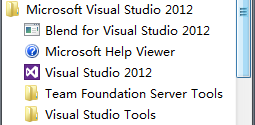使用QT来制作串口终端
为什么要使用QT,因为它是跨平台的。
我现在使用的环境是Win7 64bit,使用VS的编译器来编译QT工程。
安装这套环境简单说一下:先到QT官网下载qt-windows-opensource-5.1.1-msvc2012_opengl-x86_64-offline,然后安装它
(BUT,最近我把QtCreator改成使用Mingw编译了,直接下载带有Mingw32的版本就可以了,这样可以编译出同时在64和32下运行的程序!!)
再自己安装一个VS,我这里安装的是VS2012的
这样就可以在QT Creator中找到编译器了
我现在是打算使用QT来做一个串口收发工具,网上找了找相关的资料,发现有两种:qextserialport和QtSerialPort,前者在sourceforge里可以下载得到,后者嘛是QT自带的。我这里选择使用后者,可以参考下面网页上的资料:
http://qt-project.org/doc/qt-5.1/qtserialport/examples.html(已经失效)
http://qt-project.org/doc/qt-5/qtserialport-examples.html
由于我对QT也不太熟悉,所以我先弄一个最简单的控制台程序来开始串口编程。这里的例子就是cenumerator
新建一个QT控制台程序,很简单,选择了控制台程序之后都下一步就可以了。
把里面的源码下载下来,覆盖掉main.cpp
1 /**************************************************************************** 2 ** 3 ** Copyright (C) 2012 Laszlo Papp <[email protected]> 4 ** Contact: http://www.qt-project.org/legal 5 ** 6 ** This file is part of the QtSerialPort module of the Qt Toolkit. 7 ** 8 ** $QT_BEGIN_LICENSE:LGPL$ 9 ** Commercial License Usage 10 ** Licensees holding valid commercial Qt licenses may use this file in 11 ** accordance with the commercial license agreement provided with the 12 ** Software or, alternatively, in accordance with the terms contained in 13 ** a written agreement between you and Digia. For licensing terms and 14 ** conditions see http://qt.digia.com/licensing. For further information 15 ** use the contact form at http://qt.digia.com/contact-us. 16 ** 17 ** GNU Lesser General Public License Usage 18 ** Alternatively, this file may be used under the terms of the GNU Lesser 19 ** General Public License version 2.1 as published by the Free Software 20 ** Foundation and appearing in the file LICENSE.LGPL included in the 21 ** packaging of this file. Please review the following information to 22 ** ensure the GNU Lesser General Public License version 2.1 requirements 23 ** will be met: http://www.gnu.org/licenses/old-licenses/lgpl-2.1.html. 24 ** 25 ** In addition, as a special exception, Digia gives you certain additional 26 ** rights. These rights are described in the Digia Qt LGPL Exception 27 ** version 1.1, included in the file LGPL_EXCEPTION.txt in this package. 28 ** 29 ** GNU General Public License Usage 30 ** Alternatively, this file may be used under the terms of the GNU 31 ** General Public License version 3.0 as published by the Free Software 32 ** Foundation and appearing in the file LICENSE.GPL included in the 33 ** packaging of this file. Please review the following information to 34 ** ensure the GNU General Public License version 3.0 requirements will be 35 ** met: http://www.gnu.org/copyleft/gpl.html. 36 ** 37 ** 38 ** $QT_END_LICENSE$ 39 ** 40 ****************************************************************************/ 41 42 #include <QTextStream> 43 #include <QCoreApplication> 44 #include <QtSerialPort/QSerialPortInfo> 45 46 QT_USE_NAMESPACE 47 48 int main(int argc, char *argv[]) 49 { 50 QCoreApplication a(argc, argv); 51 QTextStream out(stdout); 52 QList<QSerialPortInfo> serialPortInfoList = QSerialPortInfo::availablePorts(); 53 54 out << QObject::tr("Total number of ports available: ") << serialPortInfoList.count() << endl; 55 56 foreach (const QSerialPortInfo &serialPortInfo, serialPortInfoList) { 57 out << endl 58 << QObject::tr("Port: ") << serialPortInfo.portName() << endl 59 << QObject::tr("Location: ") << serialPortInfo.systemLocation() << endl 60 << QObject::tr("Description: ") << serialPortInfo.description() << endl 61 << QObject::tr("Manufacturer: ") << serialPortInfo.manufacturer() << endl 62 << QObject::tr("Vendor Identifier: ") << (serialPortInfo.hasVendorIdentifier() ? QByteArray::number(serialPortInfo.vendorIdentifier(), 16) : QByteArray()) << endl 63 << QObject::tr("Product Identifier: ") << (serialPortInfo.hasProductIdentifier() ? QByteArray::number(serialPortInfo.productIdentifier(), 16) : QByteArray()) << endl 64 << QObject::tr("Busy: ") << (serialPortInfo.isBusy() ? QObject::tr("Yes") : QObject::tr("No")) << endl; 65 } 66 67 return 0; 68 }
再把cenumerator.pro文件下载下来覆盖新建工程的pro文件,如果嫌烦那只要在我们的QT += core后面加上serialport即可(与core空格隔开)。
1 #------------------------------------------------- 2 # 3 # Project created by QtCreator 2013-12-12T09:17:54 4 # 5 #------------------------------------------------- 6 7 QT += core serialport 8 9 QT -= gui 10 11 TARGET = cenumerator 12 CONFIG += console 13 CONFIG -= app_bundle 14 15 TEMPLATE = app 16 17 SOURCES += main.cpp
编译运行即可了。编译目录会在工程的上一级菜单中!这样的结构容易会把工程弄乱。
这会我把构建和运行中的默认构建目录改成当前文件,在删除了所有makefile文件之后,QT Creator可以正确地编译出exe文件来,但会提示“警告:Qmake不支持源文件目录下的构建目录”什么的云云。
虽然我们现在编译是没有问题,但这终究是一个隐患。
所以,最后我还是决定不去修改默认构建目录了,让它恢复成../build-%{CurrentProject:Name}-%{CurrentKit:FileSystemName}-%{CurrentBuild:Name},这样默认情况下它还是在上级目录中生成中间文件及最终应用程序。但我对工程本身进行一些设置,使得QT会把编译得的中间文件保存到工程目录下面:
打开项目 -> 构建和运行 -> 概要,不再选中Shadow build,这样工程的编译就会在工程目录下面进行了,也不会再提示“警告:Qmake不支持源文件目录下的构建目录”的错误了。
喏,看现在所有文件都平躺着了,更清晰一些。
来运行一看看情况吧,枚举串口:







